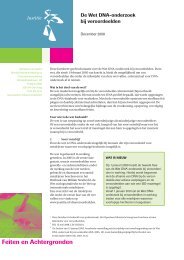INTERPOL HANDBOOK ON DNA DATA EXCHANGE AND PRACTICE
INTERPOL HANDBOOK ON DNA DATA EXCHANGE AND PRACTICE
INTERPOL HANDBOOK ON DNA DATA EXCHANGE AND PRACTICE
Create successful ePaper yourself
Turn your PDF publications into a flip-book with our unique Google optimized e-Paper software.
THE MATCH REPORTTo get to step 5 of figure 1- Comparison and Interpretation, the profile above needstranslating into an alphanumeric code. This code states the number of repeats presentat each locus and it is this data that is entered into the database, as shown below:(please note this is not linked to the above image of a <strong>DNA</strong> profile and is a fictitious profile).Reference: FP/01/09/csVWA TH01 D21S11 FGA D8S1179 D3S1358 D18S51 amelogenin16 20 9 93 30 31,2 19 22 14 15 16 17 13 14 X XTPOX CSF1P0 D13S317 D7S820 D5S818 D16S539 D2S1338 D19S43312 12 11 10 23 23 13 15,2Penta A Penta E FES F13A1 F13B SE33 CD4 GABAFigure 3: <strong>DNA</strong> Profile for entry in a <strong>DNA</strong> DatabaseNormally, the database will then search this profile entered against all profiles alreadypresent and will store the profile for future searches, unless there are other specificrequirements.•what do the results mean?1. Exclusion (Non-match)The <strong>DNA</strong> profile from the known individual (reference sample from a victim, otherwiseknown as an elimination sample or suspect) does not match the <strong>DNA</strong> profile generatedfrom the crime scene evidence.2. Inclusion (Match)The <strong>DNA</strong> profile from the known individuals (reference samples from victim orsuspect) matches the <strong>DNA</strong> profile obtained from the crime scene evidence. The twoprofiles are consistent with originating from the same source.PAGE 34THE MATCH REPORT







